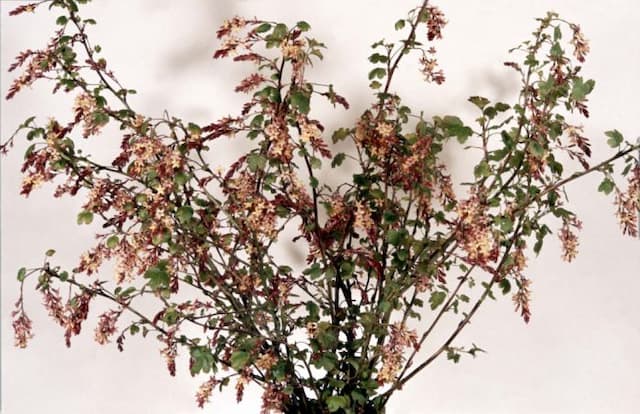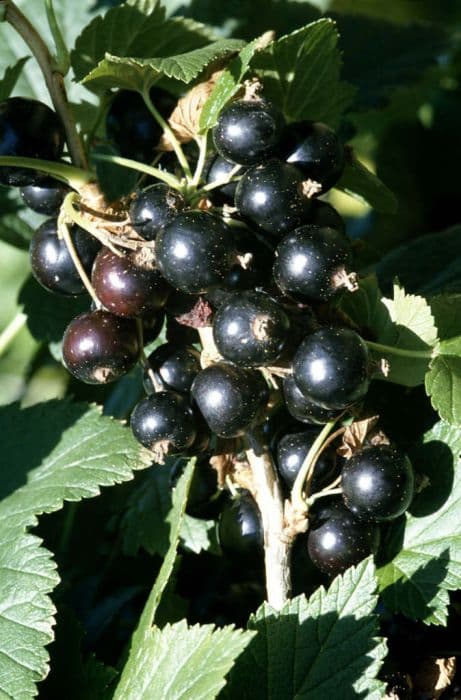Flowering Currant Ribes sanguineum 'Pulborough Scarlet'

ABOUT
The Ribes sanguineum 'Pulborough Scarlet', more commonly known as the flowering currant, is a visually striking shrub known for its vibrant display of flowers and foliage. The plant is adorned with clusters of eye-catching scarlet flowers that hang in showy racemes, creating a cascading effect that is particularly spectacular during its blooming season in spring. These flowers are a magnet for pollinators, providing an early season nectar source for bees and butterflies. The leaves of the flowering currant are generally lobed, resembling those of maple trees, and have a bright green hue that forms a lush backdrop to the bright flowers. In autumn, the foliage may take on yellow to reddish-purple tones, adding yet more visual interest to the landscape. The shrub's stems are upright and arching, giving it a graceful appearance even when not in bloom. The bark is typically smooth with an understated brown color that allows the flowers and foliage to be the primary focus. Overall, the flowering currant 'Pulborough Scarlet' presents a charming and colorful addition to gardens, bringing both aesthetic appeal and wildlife interest.
About this plant
 Names
NamesSynonyms
Red Flowering Currant, Blood Currant, Pink Flowering Currant, Pulborough Scarlet Flowering Currant, Winter Currant.
Common names
Ribes sanguineum 'Pulborough Scarlet'.
 Toxicity
ToxicityTo humans
Flowering currant (Ribes sanguineum 'Pulborough Scarlet') is not commonly known as a toxic plant to humans. There are no significant reports of toxicity arising from ingesting this plant, and it is generally considered safe around humans. However, as with many plants, individual sensitivities can vary, and it is generally advised to avoid ingesting plant material that is not known to be edible.
To pets
Flowering currant is also not known to be toxic to pets. There is no widely recognized evidence that the plant poses a significant threat upon ingestion. As with humans, it's always prudent to prevent pets from eating plants not intended for consumption, as individual reactions can vary, but there are no specific symptoms of poisoning associated with Flowering currant typically recorded for pets.
 Characteristics
CharacteristicsLife cycle
Perennials
Foliage type
Deciduous
Color of leaves
Green
Flower color
Scarlet
Height
4-6 feet (1.2-1.8 meters)
Spread
4-6 feet (1.2-1.8 meters)
Plant type
Shrub
Hardiness zones
6
Native area
Pacific Northwest
Benefits
 General Benefits
General Benefits- Attracts Pollinators: Ribes sanguineum 'Pulborough Scarlet', commonly known as Flowering Currant, attracts bees, butterflies, and other beneficial insects, supporting biodiversity.
- Aesthetic Appeal: It has vibrant scarlet flowers that add color and visual interest to gardens in the spring season.
- Low Maintenance: Flowering Currant is known for being easy to grow and requiring minimal care once established, making it suitable for novice gardeners.
- Drought Tolerance: Once established, it has good drought tolerance, making it suitable for regions with water scarcity or for xeriscaping.
- Wildlife Friendly: The shrub provides shelter and nesting sites for birds, and its berries serve as a food source in late summer.
- Adaptable: It is adaptable to a range of soil types as long as there is adequate drainage.
- Seasonal Interest: Flowering Currant offers year-round interest with flowers in spring, berries in summer, and foliage changes in autumn.
- Naturalization: It can naturalize in suitable climates and environments, filling out garden spaces without becoming invasive.
 Medical Properties
Medical PropertiesThis plant is not used for medical purposes.
 Air-purifying Qualities
Air-purifying QualitiesThis plant is not specifically known for air purifying qualities.
 Other Uses
Other Uses- Ribes sanguineum 'Pulborough Scarlet', commonly known as flowering currant, can be used as a natural dye source. The berries produce a blue or purple dye that can color textiles and crafts.
- Flowering currant branches can be used in floral arrangements to add height and a burst of color with their vibrant pink-red flowers.
- The plant can serve as habitat and shelter for birds and small wildlife, which often seek refuge in its dense foliage.
- Flowering currant can be included in a sensory garden for its appealing and fragrant blossoms that attract pollinators like butterflies and bees.
- The foliage of the flowering currant can be used in garlands or wreaths to create festive decorations during springtime.
- When pruned, the wood of Ribes sanguineum 'Pulborough Scarlet' can be used for small woodworking projects or as part of rustic crafts.
- The plant's striking appearance can be utilized in landscape photography as a focal point or to enhance the aesthetic of natural scenes.
- Flowering currant can be used in educational settings to teach about plant reproduction and the importance of pollinators.
- With its dense growth, flowering currant can be used as a natural screen or windbreak in gardens and landscapes.
- The nectar-rich flowers can be observed to study the foraging behavior of native hummingbirds and other nectar feeders.
Interesting Facts
 Feng Shui
Feng ShuiThe Flowering Currant is not used in Feng Shui practice.
 Zodiac Sign Compitability
Zodiac Sign CompitabilityThe Flowering Currant is not used in astrology practice.
 Plant Symbolism
Plant Symbolism- Passion and Love: The 'Pulborough Scarlet' variety of Flowering Currant is often associated with passion and love, likely due to its vibrant and deep red flowers, which evoke strong emotions and a sense of romance.
- Prosperity: As a plant that blossoms abundantly in the spring, Flowering Currant can symbolize growth and prosperity, representing the idea of burgeoning wealth and success.
- Youthfulness and Vitality: The fresh and bright appearance of the Flowering Currant's spring flowers is a nod to the vigor and energy of youth, symbolizing renewal and the fresh start that comes with the season.
- Spiritual Awakening: Flowering Currant blossoms at a time of year that is often associated with renewal and rebirth, which can be seen as a metaphor for spiritual awakening or enlightenment.
 Water
WaterThe Flowering Currant should be watered deeply once a week during the growing season, ensuring that it receives about 1.5 inches of water each time. In the summer heat or if planted in well-draining soil, you may need to increase watering to twice a week. During the winter months, reduce watering to every two weeks, but do not let the soil completely dry out. Ensure the soil is moist but not waterlogged, as Flowering Currant prefers consistent moisture without being overly saturated. It is best to use a soaker hose or drip irrigation to deliver water directly to the root zone, which encourages deep root growth and reduces leaf wetness that can lead to disease.
 Light
LightFlowering Currants thrive in full sun to partial shade. They prefer a location that receives at least 4 to 6 hours of sunlight a day, but they can tolerate some light afternoon shade, particularly in hotter climates. Avoid placing them in deep shade, as this will result in fewer blooms and weaker growth.
 Temperature
TemperatureThe Flowering Currant is hardy and can withstand a wide range of temperatures, ideally thriving between 60 and 75 degrees Fahrenheit. It can endure winter chill down to about 20 degrees Fahrenheit but should be protected from prolonged exposure to temperatures below this point. This plant is adaptable and can grow well in the typical temperature conditions found in USDA hardiness zones 6 through 9.
 Pruning
PruningPruning Flowering Currants is essential to maintain a desirable shape, remove dead or diseased wood, and encourage the growth of flowering shoots for the next season. Pruning should be done immediately after the blooming period, typically in late spring or early summer. Remove approximately one-third of the old wood to ground level annually, which helps rejuvenate the plant and promotes vigorous growth.
 Cleaning
CleaningAs needed
 Soil
SoilThe Flowering Currant thrives in a soil mix that is well-draining and rich in organic matter with a pH around 6.0 to 7.0. A good recipe for soil would be a blend of garden soil, compost, coarse sand, and peat moss to ensure adequate drainage and fertility.
 Repotting
RepottingFlowering Currants don't generally require frequent repotting; it's often sufficient to repot every 2-3 years to refresh the soil and provide space for growing roots.
 Humidity & Misting
Humidity & MistingFlowering Currant prefers moderate humidity levels but is quite adaptable and can tolerate a range of humidity conditions commonly found in outdoor environments.
 Suitable locations
Suitable locationsIndoor
Place in a bright spot, minimal direct sun, water regularly.
Outdoor
Plant in partial sun, well-draining soil, hardy shrub.
Hardiness zone
6-9 USDA
 Life cycle
Life cycleRibes sanguineum 'Pulborough Scarlet', commonly known as red-flowering currant, begins its lifecycle as a dormant seed, which germinates once it experiences the appropriate conditions of moisture and temperature. The seed develops into a seedling, which will eventually establish a root system and grow into a young plant, featuring characteristic lobed leaves. As the plant matures, it enters a vegetative state where it focuses on growth, producing stems and leaves in preparation for the reproductive phase. In spring, the red-flowering currant produces vibrant red flowers, attracting pollinators and subsequently producing fruit which contains seeds for the next generation of plants. After fruiting, the plant enters a period of dormancy, especially in colder climates, conserving energy by shedding leaves and halting active growth. The cycle recommences with the next growing season, when temperatures rise and conditions again become favorable for growth and further development.
 Propogation
PropogationPropogation time
Spring-Early Summer
The most popular method of propagating the Red Flowering Currant 'Pulborough Scarlet' is through softwood cuttings. This technique is typically conducted in late spring or early summer when the plant's new growth is still tender and green, but has begun to mature and harden slightly. To propagate by cuttings, one would cut a 4 to 6 inch (approximately 10 to 15 centimeters) length of stem just below a leaf node, strip off the lower leaves, and dip the cut end in rooting hormone powder or gel. The treated cutting is then planted in a pot filled with a mixture of peat and perlite or sand to facilitate drainage. It’s essential to keep the cutting moist and in a warm, well-lit environment but out of direct sunlight, until roots develop, usually within a few weeks to a couple of months. Once rooted, the cuttings can be transplanted into individual pots to grow on or directly into their final position in the garden.








